Dell UltraSharp U2711: Quality has a Price
by Jarred Walton on January 22, 2010 2:00 AM EST- Posted in
- Displays
Dell U2711 Color Quality
We'll start with a look at the color quality of the U2711, broken down into two areas: Color gamut and color accuracy (i.e. Delta E). We'll start by explaining the former. Color gamut refers to the ability for a display to represent all of the colors in a defined selection of colors. In this case, we use the Adobe RGB standard to define the base gamut, and we measure the percentage of that standard that a display is able to cover - higher being better.
Delta E is the difference between a requested color and the color that actually appears on the display, with lower being better - i.e. the displayed color doesn't have a large delta relative to what was requested. If a display has perfect color accuracy, Delta E will be 0.0; in practice, anything less than 1.0 is nearly perfect and no one will notice the difference. A Delta E of 2.0 or less is the desired result after calibration, meaning no one color measures higher than 2.0 on our standard 24 color palette. Such a result would be fit for use in any professional imaging environment. Finally, while Delta E of around 4.0 is visible to the naked eye, it's really a question of reference points; if you don't have something better nearby and you're not going to print or view content on other media, a result where all colors measure 4.0 or less is very good.
So how does the U2711 do in these areas? First let's look at the charts, and then we'll discuss what they mean. We used the Graphics and Adobe RGB setting on the U2711, with brightness set at 36% (~200nits) and contrast at the default 50%.

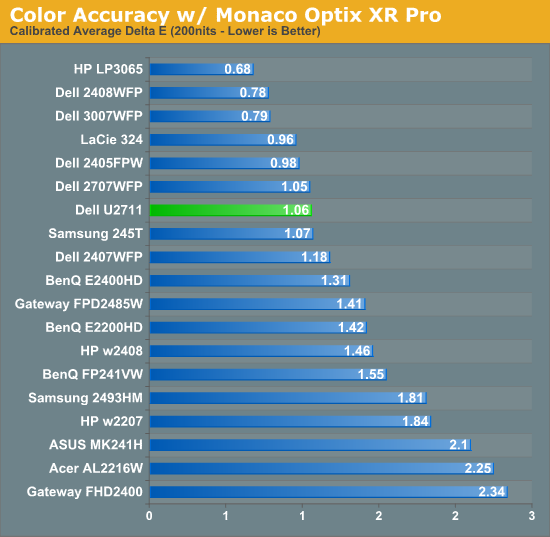
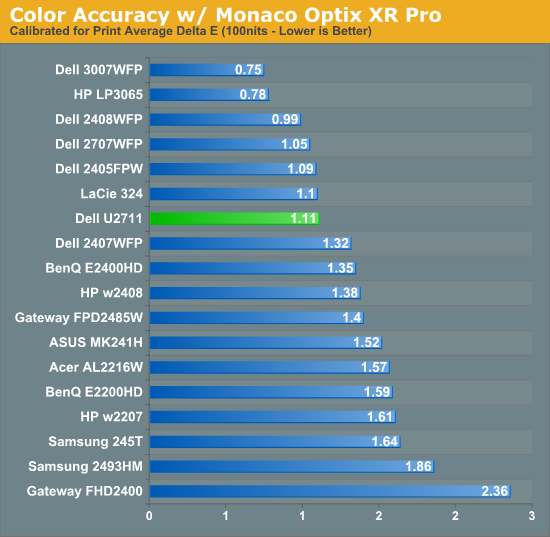
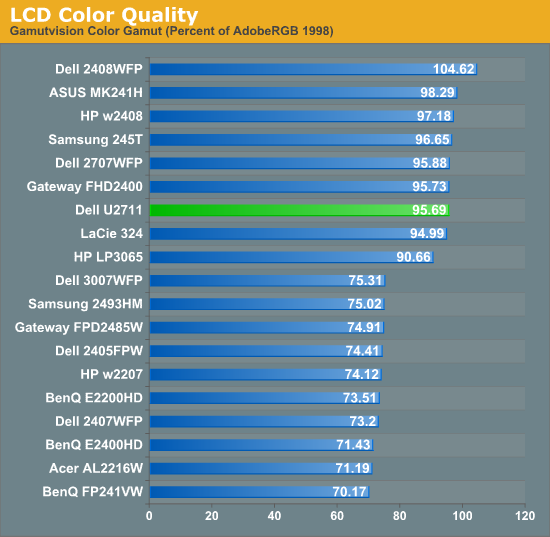
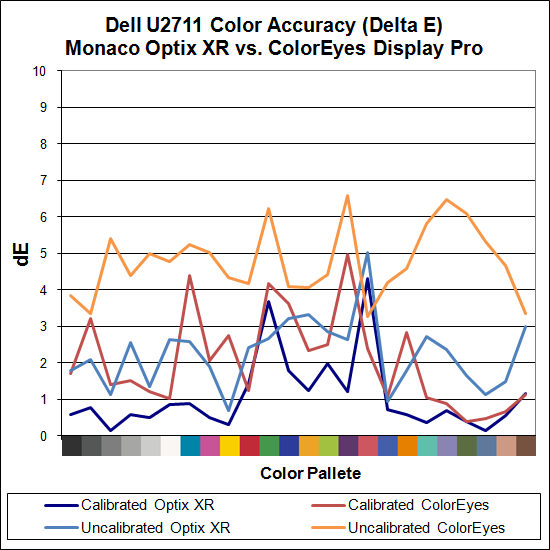
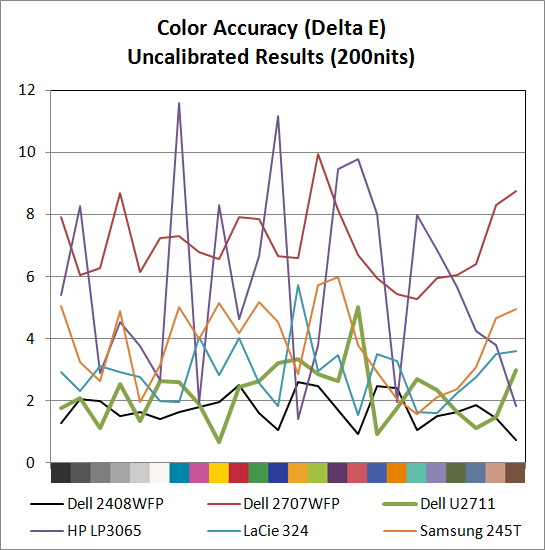
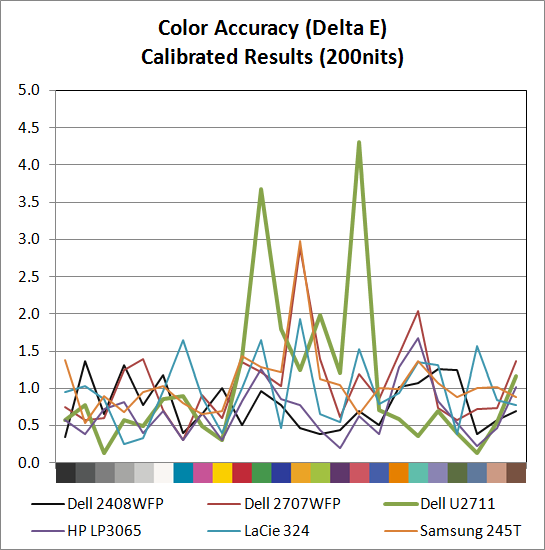
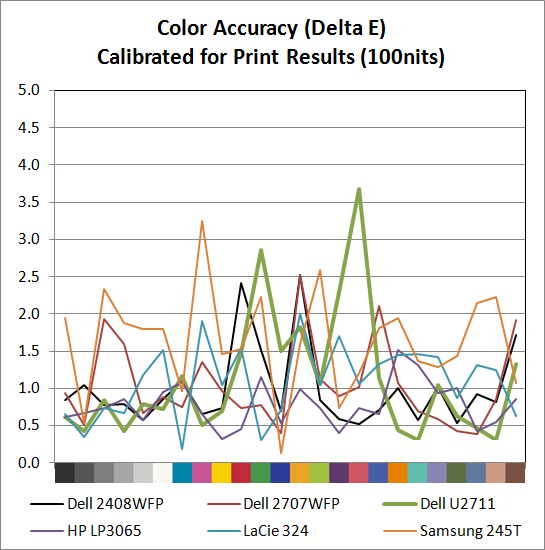
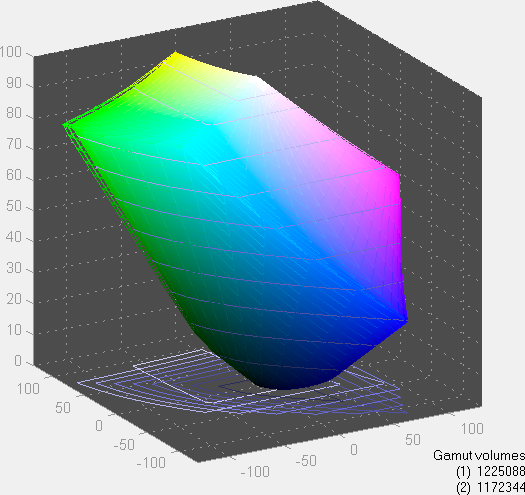
The U2711 scores extremely well in color gamut, and it achieves the 96% of Adobe RGB that Dell claims in their literature (not that most users would really notice the difference between any of the displays rated 90% to 105% - at least not after you eliminate the TN panels). Color accuracy on the other hand is a bit of a mixed bag. Dell ships a paper with test results showing the color calibration of each individual U2711, with the claim that the displays will have an average Delta E of less than 5.0 without any end-user calibration (when using the sRGB and Adobe RGB settings). Dell uses Minolta Color Analyzer CA210 and 32 test colors while we test with ColorEyes Display Pro and Monaco Optix XR Pro and 24 test colors, but our Monaco results confirm their claim. We're not sure why, but we continue to get better results using Optix XR Pro than with ColorEyes Display Pro.
As far as Optix is concerned, the U2711 achieves the rated Delta E of < 5.0 at just 2.24 without calibration, which is an excellent result. In fact the U2711 has no colors in the standard Gretag Macbeth 24 color palette score higher than 5.0 (and only reddish-pink scores a 5.0 measurement). The only LCD we've tested that did better is Dell's own 2408WFP (which also, interestingly enough, had an Adobe RGB color gamut of 105%). ColorEyes also gives an average Delta E of less than 5.0, but at 4.78 the score isn't nearly as remarkable, with nine color measurements well above 5.0. The uncalibrated (Monaco) results put the U2711 ahead of the HP LP3065, Dell 2707WFP, Samsung 245T, and LaCie 324 - and just about every other LCD we've tested.
Switch to the calibrated results and the U2711 doesn't impress quite as much relative to the competition. Monaco gives the U2711 an average Delta E of 1.06, which is great, but there are two results above 3.0 (the worst is reddish-pink again, this time at 4.31) compared to displays like the HP LP3065 where the highest measured Delta E is just 1.68. Dell's own 2707WFP, a three-year-old offering, also delivered a similar average Delta E but with only two colors above 2.0 (and still under 3.0). For a better LCD (i.e. not a TN panel), the results are really only slightly above average. It is possible different calibration software would achieve a better end result, but really we're talking about a "problem" that only the most demanding users are likely to ever notice.
Color Consistency
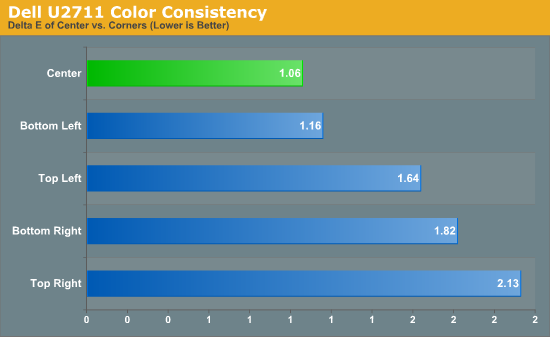
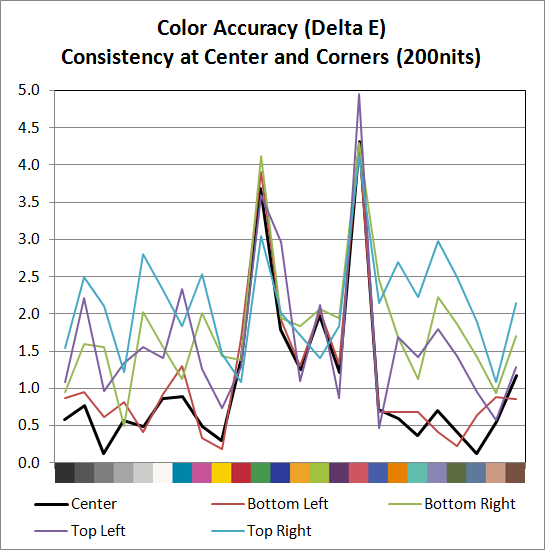
We added another test to try and measure the panel consistency across the entire surface. We measure Delta E at the center of the display, but what happens on the edges? To test this, we used the same profile generated in our best Delta E test result and measured Delta E again at the four corners. Most of the scores are similar, with a slight increase in average Delta E relative to the center measurement. The bottom-left corner is nearly identical to the center measurement, the top-left and bottom-right are a bit worse, and the top-right corner gets the overall worst result. While on the one hand we could say that the Delta E on the top-right is twice that of the center measurement, it's not a case of being "twice as bad". In fact, the color consistency is very good, and we didn't notice any "hot spots" are areas where the colors were clearly off relative to the rest of the LCD.










153 Comments
View All Comments
Hxx - Saturday, January 23, 2010 - link
if you need anything bigger than a 24 inch for gaming youre better off with a nice led or lcd tv (40 inch or so is perfect) hook up your machine to it and youre in business. seems rather pointless to spend that much money for a monitor unless youre using it for something other than games/movies.FlyTexas - Sunday, January 24, 2010 - link
Yuck...Who wants a 32" LCD running at 1280x720 2 feet in front of you?
Blah...
Besides, those TVs were meant and designed to be watched from 6-10 ft away, not for close up viewing. Even if you got a 1080P panel, it would still have half the resolution of a 30" desktop LCD (at 2560x1600, it has 4 million pixels compared to 2 million on the 1080P or 1 million on the 720P)
Now, I have seen HDTVs used as computer monitors for wall displays of information in companies, but again those are meant to be viewed 6-10 ft away, not to be put on your desktop.
erple2 - Saturday, January 23, 2010 - link
I think that the GP was referring not to the actual size of the monitor, but the resolution of the monitor. The problem with the LCD or LED TV's is that they run at (at best) 1920x1080 resolution. This screen has substantially higher resolution to it. The dot pitch of those screens are pretty .. terrible in fact.When will people understand the difference between dot pitch and physical screen size?
erple2 - Saturday, January 23, 2010 - link
Also, if you do any kind of image manipulation (Photoshop-style of CAD style) you want a high resolution screen more than a physically large screen. While it's generally true that larger screens have higher resolution, that isn't generally the case. In fact, it reverses the trend once you start going with TV's...evilspoons - Saturday, January 23, 2010 - link
I disagree; the 3008WFP is an older model with slower signal processing and narrower black levels.I bought a U2410, it is amazing, period. You put it in 'game' mode and the input lag drops to ~15 ms, which is one of the best LCDs on the market today. (Check out the review on tftreview.co.uk - no affiliation here except I read their review before I bought my U2410.)
FlyTexas - Sunday, January 24, 2010 - link
Err... Maybe... But you're comparing a $500 24" monitor with a $1,000 30" monitor. Not really in the same league...If you want/need a 24" monitor, that is probably a very good one. If you have never used a 30" monitor, you don't know what you're missing.
To each his own... :)
evilspoons - Tuesday, January 26, 2010 - link
I had a 30" monitor (an LG with an IPS panel) and found it was excellent except for the huge lack of signal processing abilities (no scaler, one input). I also found that playing games on it was inconvenient because I'd actually have to turn my head to see the entire picture at my desk.Anyway, the U2410 is $750 MSRP and the U2710 is $1000 MSRP. Compare apples to apples. It's on sale for $500 off and on, and I expect the U2711 to be on sale in the same manner fairly soon. What I'm saying is the U2410 is excellent for certain things that the U2711 presumably is and the WFP3008/9/whatever isn't. It's not for everyone but I'm offering an alternative.
Zebo - Friday, January 22, 2010 - link
No it wouldnt. It's grainy if you have good eyesight with its huge pixel pitch ~.255 vs . 233 for this model. I wish LCD makers would get below .15 but is a start.rbnn - Friday, March 12, 2010 - link
Hi,Very interesting review, thanks. Still, I am not a monitor expert and just use ordinary apps in Windows 7:
(1) Text - reading web pages (chrome), using Word and PDF (often multiple large text docs open at once);
(2) Blu-ray.
Is the monitor good for these?
I frankly did not understand your comment about smaller dot-pitch being bad. Wouldn't smaller dot pitch be good, as you get crisper text? Being able to see large pdf pages, or multiple ones, at full size on would seem to be helped by smaller dot pitch, not hindered. I just don't understand your comment there. You can always just reset software to magnify if text is too small, is that what you were complaining about?
Griswold - Sunday, January 24, 2010 - link
Bullshit. Get a reality check. Just because it suits YOU, doesnt mean it suits the majority.